How to Assess Museum CMS Data for Enhancement Opportunities

Rachael Cristine Woody
Data enhancement has the power to improve the discoverability of objects in the museum Collections Management System (CMS). This post offers prompts that can reveal enhancement opportunities specific to your museum collection.
Today’s post will continue our exploration of museum data enhancement. Data enhancement is both the enhancement of existing data in required fields and the creation of data for areas of the object record that fall into the recommended section of descriptive best practices. In last week’s post, we reviewed the common fields targeted for enhancement.
The “Worth it” Factor
Our focus is on how to meaningfully enhance object data. In this case, it’s not about adding more specific data such as dates or dimensions, nor is it about filling in required fields. These aspects should be taken care of already if you’re considering enhanced cataloging. With this in mind, it’s up to us to consider what meaningful enhancement is. This may be informed (in part) based upon past reference requests and statistics on access and usage. Additional aspects to consider include anticipated access to new resources and potential for use in scholarly work and exhibits.
For example: There’s a symposium scheduled for later this year that will offer an opportunity for further research regarding a set of objects. Capturing and including the resulting research information in the records isn’t required, but it is a meaningful addition to the object record.
Prompts to Help Reveal Enhancement Opportunities
- What data exists but could be meaningfully enhanced with further descriptive work?
- Where do opportunities exist to capitalize on in-depth research, a past exhibit, educational programs, or events?
- Which areas of the collection share affinities that can be leveraged to provide further contextual knowledge, or lend an efficiency in further research?
As you think through these prompts and identify areas for possible enhancement, it’s equally important that these opportunities be evaluated for the “worth it” factor.
Examples of Data Enhancement Opportunities
To help get the ideas flowing, this section will review each of the main fields targeted for data enhancement and offer examples of possible improvements.
As a refresher, the common fields targeted for data enhancement are:
- Biographies or Historical Notes
- Description
- Provenance
- Related Materials
- Subjects
- Places
Biographies or Historical Note: Further information on who/what created the item, who/what acquired the item, who/what worked with the item, etc.
Description: The historical context of when, where, why, and how the item was made, used, or enjoyed. Any remarkable pieces of information that can enhance the meaning of the item, its interpretation, etc.
Provenance: The publishing of transparent ownership history for an item.
Related Materials: A list or link to peer items, archival materials, special collections books, exhibit -generated material, etc.
Subjects: Capturing more detailed (narrowed) subjects, or additional subject matter.
Places: Much like Subjects, Places is a field that could benefit from a more detailed location with related considerations of separating out or adding a cultural community. Please see last week’s post for an explanation on why these two concepts were historically tied.
Considering the Objects
If thinking about fields is difficult to conceptualize for enhancement opportunities, then sometimes an evaluation of the objects can help provide ideas. Try considering the following “tried and true” prompts for prioritizing regular cataloging work:
- Which items are used the most?
- Which items may be used more if information was more readily available?
- Which items help to diversify the currently known collection?
- Which items may help to drive stakeholder interest?
- Which items may share similarities in information?
With the ultimate question being: How can we leverage work with these items to further enhance their data?
Conclusion
Now that we’ve identified data enhancement opportunities, it’s time to create a plan! Next week we will review how to create a plan for CMS data enhancement with our final post covering the details of how to perform it.

Rachael Cristine Woody
To learn more, please join us for a free webinar How to Perform Data Enhancement for Your Museum CMS Wednesday, May 29 at 11 a.m. Pacific, 2 p.m. Eastern. (Can’t make it? Register anyway and we will send you a link to the recording afterwards). Register now.
Never miss another post. Subscribe today!
Similar Posts
Museum TrendsWatch 2024: Culture Wars 2.0
Expert analysis and commentary on Museum TrendsWatch 2024: Culture Wars 2.0 from AAM’s Center for the Future of Museums
How to Perform Museum CMS Data Enhancement
Detailed expert guidance on the four main options for data enhancement within a CMS, and tips for when it makes sense to use each one.
How to Create a Plan for Museum CMS Data Enhancement
Detailed guidance on the elements of a data enhancement plan that will improve the discoverability of objects in the museum Collections Management System (CMS).
An Overview of Common CMS Data Areas to Enhance
Data enhancement has the power to improve the discoverability of objects in the museum Collections Management System (CMS)
Hosting service
Enjoy all of the benefits of your Lucidea solution with secure, reliable, stress free hosting
Programs & incentives
No matter your size or budget, we’ve got you covered, today and tomorrow




Leave a Comment
Comments are reviewed and must adhere to our comments policy.
0 Comments